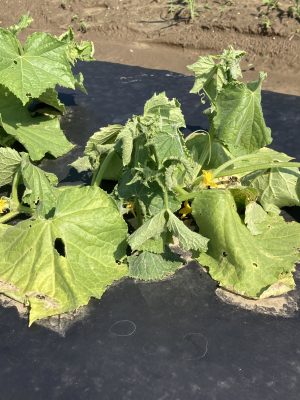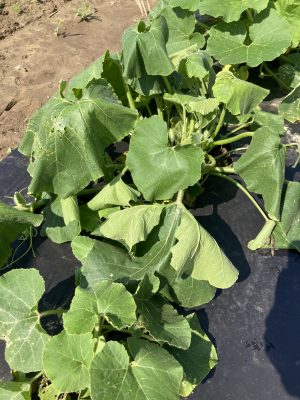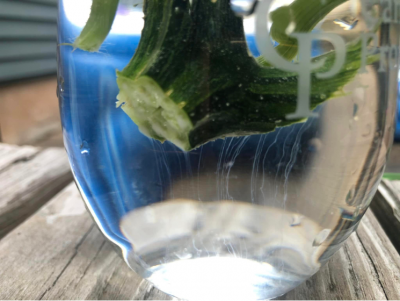Bacterial Wilt of Cucurbits

Bacterial wilt is a serious disease caused by Erwinia tracheiphila. It can severely affect cantaloupe, muskmelon, and cucumbers, and, less severely, summer squash and pumpkin. Watermelon is resistant to this disease. Many wild cucurbit species can be infected by this bacterium as well. This disease was first reported in 1893 in Washington D.C. It is now widespread in North America, and is also in Europe and Asia. It is a serious threat to commercial melon production in some areas. It can kill the plants within two weeks if they are infected while young. Seedlings at the cotyledon and 1- to 3-leaf stage are more susceptible to infection with bacterial wilt than older plants. Thus, it is especially important to keep beetle numbers low before the 5-leaf stage. Spots on fruit predispose them to storage rots caused by other bacteria.
Bacterial wilt is vectored by the striped cucumber beetle and, less often, the spotted cucumber beetle. E. tracheiphila survives in the gut of the beetles, and is spread through feeding activity as infected mouthparts come into contact with plant tissue. The more feeding damage and higher presence of beetle, the greater the instance of bacterial wilt.
Symptoms: Symptoms can begin at any time in the season; whenever the beetles that spread the disease are feeding. It is usually more severe early in the season, when the plants are growing rapidly. The first symptom is seen around the chewed areas on the leaf, where the leaf tissue becomes dull green and the leaf wilts rapidly. The wilt then progresses outwards in the plant, so that the tip of that vine is wilted. Later, the entire vine will wilt, and finally the entire plant. The leaf may wilt in 5-6 days, and the whole plant in as little as 2 weeks in young plants; older plants generally take longer. Small water-soaked areas appear on the fruit surface. If a spot is cut, small glistening droplets ooze out. Fruit often gets a slime rot in storage from other bacteria invading it at these spots.

Identification of disease: When the stem is cut, a sticky, milky goo oozes out. If the cut ends of the stem are touched together, and then pulled apart, strings of delicate threads, like spider webs, stretch between the ends. This works well for cucumbers, but not muskmelons. Another way to identify this disease is to put the cut end of the stem in a glass of water. In 15 minutes, one can see bacteria streaming out (see photo below).

Vector: This disease is spread from infected to healthy plants only by the spotted (Diabrotica undecimpunctata howardi) and striped (Acalymma vittata) cucumber beetles. The striped cucumber beetle has a black head, a yellow-orange thorax, and yellow and black stripes running the length of its body. It is about 1/4″ long. The spotted cucumber beetle is about 3/8″ long, has a black head, and a yellow to yellowish green body with 12 black spots.

Prevention: The bacteria survive the winter only in cucumber beetles. It is important to control the beetles, especially early in the season.
- Use crop rotation to reduce beetle numbers.
- Rogue infected plants.
- Spunbounded row covers will exclude beetles.
- Plant a perimeter trap cropof Blue Hubbard squash to protect more susceptible crops.
- Because this bacterium is transmitted systemically by cucumber beetles, copper sprays are of no value.
- See current recommendations for chemical control of cucumber beetle control.
- Resistant varieties of cucumbers are available for this disease. No resistance has been identified in melon.
References:
- (2013, January). Cucurbits, Bacterial Wilt. UMass Extension Vegetable Program. Retrieved October 19, 2023, from https://ag.umass.edu/vegetable/fact-sheets/cucurbits-bacterial-wilt#:~:text=Masses%20of%20bacteria%2C%20gums%2C%20and,of%20bacteria%20for%20subsequent%20infections.
- Latin, R.X. 1996. Bacterial Wilt in Compendium of Cucurbit Diseases. T. A. Zitter, D. L. Hopkins, and C. E. Thomas, eds. APS Press, St. Paul, MN. p. 36
- Sherf, A.F. and A. A. MacNab. 1986. Vegetable Diseases and Their Control. John Wiley and Sons, New York.
- Wick, R. L. 1997. Proceedings of the New England Vegetable and Berry Conference. Cooperative Extension System.r
- York, A. 1992. Pests of Cucurbit Crops in Vegetable Crop Pests, R.G. McKinlay, ed. CRC Press, Inc, Boca Raton, FL. Chapter 5
By Pamela S. Mercure, IPM Program Assistant, University of Connecticut
Reviewed by: T. Jude Boucher, IPM, University of Connecticut. 2012
Updated by: Maggie Ng and Shuresh Ghimire, 2023